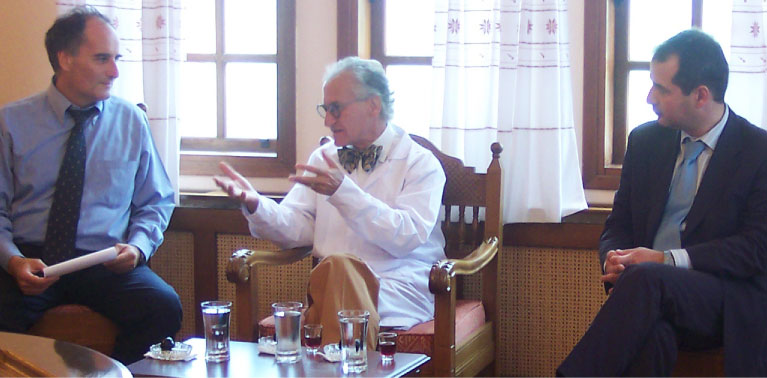NEWS AND EVENTS
2021
Robotic WideField Breast Ultrasound Tomography Platform.
FocusWest Health begins to assemble its unique medical team composed of international experts in key areas.
2019
Quality Improvement
Comments of technologists from a recent QI program for a private facility:
"Thank you so much for all of the wonderful knowledge and teaching...."
"We gained a lot of knowledge...."
"...instruction tips and evaluation of my images will definitely help me get better images and be a better mammographer."
2014
Follow up data from the QI program at Stanford University breast imaging section
Follow up data from the QI program at Stanford University breast imaging section confirms a significant decrease in repeat/additional images. Images are more consistent, less technologist's time required. Less room time required. Better patient flow and satisfaction. Major cost saving.
2014
Dr Kivitz provided a QI program for the breast imaging section of Stanford University
In February 2014, Dr Kivitz presents a QI program for the Stanford University breast imaging section. The mammography technologist’s material covers positioning and MQSA standards. Supervised hands-on positioning of mammography patients follows. Each case is discussed and critiqued with the technologists.
Later in the day, Dr Kivitz lectures the radiologists, including faculty, fellows and residents, to establish uniform standards of expectation for clinical images. MQSA standards are explained and stressed. The importance for all radiologists to have the same expectations for image quality is stressed. Without uniform expectations from the radiologists, technologists may be confused, and quality may falter.
This is one of several presentations on quality and MQSA that Dr Kivitz presents before the breast imaging section of Stanford University.
OCTOBER 21, 2013
New York Times, Letters to the Editor
A Global Focus on Breast Cancer
Dr Kivitz letter to the New York Times commenting on the recent breast cancer in Africa article stresses the importance of education in all populations. He reminds everyone that it was not so long ago in the United States that most women rarely told anyone when they were diagnosed with breast cancer. It was felt by many to be a stigma. As science progresses we sometimes lose sight of the emotional and the unseen impact and scars.
2012
Ormylia Foundation Panagia Philanthropini and the University of Pennsylvania Global Center for Women's and Children's Health Collaborations
Athens, Greece
On 1 October 2012, Dr Kivitz and his wife, Susan T. Marx, attend a reception at the Athens home of the United States Ambassador to Greece, Daniel B. Smith & Mrs. Diane Smith to celebrate a new collaboration between the Ormylia Foundation Panagia Philanthropini and the University of Pennsylvania Global Center for Women's and Children's Health. He and his wife are invited because of their efforts arranging this collaboration. Dr K has been involved with the Ormylia Center since 2000. His wife, a graduate of the University of Pennsylvania, learned of the newly created Global Center by the School of Nursing. Because of Ms Marx work matching non-profits to possible funders, she suggests the Global Center consider Ormylia as a possible affiliate. After a May 2012 visit to Ormylia by Dr Lynn Sommers who heads the Global Center, she and Brother Charles Anthony work together to create a formal collaboration. Prior to the reception at the Ambassador's home, Dr Sommers and several of her associates give the first three-day course at Ormylia. Plans are underway for other programs in collaboration going forward.
2012
Nuclear Mamma Porto Alegre Breast Cancer Screening Project
Brazil
Dr Kivitz spends the week auditing NMPOA breast cancer screening project which he has been supervising since 2003 in southern Brazil. Along with image quality reviews , statistical reports, recall rates, quality control , physicists’ reports and other standards, he finds the Brazilian center continues to maintain standards comparable to an MQSA US qualified facility. When the center originally opened, MQSA standards were implemented as if it required FDA accreditation. During periodic auditing visits for several years, the center is found to consistently maintain these standards.
Dr Kivitz reviews many patient charts diagnosed with cancer. Because of earlier diagnosis, fortunately many of the women do not need chemotherapy. Previously most women's cancers are found in late stages which requires chemotherapy.
The study of almost 10,000 women at this center continues for several more years before final data are available. However, preliminary data are very exciting.
2011
Breast cancer screening center
Ormylia, Greece
A few days before Thanksgiving, Dr Kivitz travels to the health center in Ormylia, Greece. The facility recently installed two new mammography machines. During prior visits he saw the need for new mammography equipment. He approaches Hologic. The company is receptive and donates the new equipment.
Working with technologists and radiologists, the transition to the new machines and images is smooth and complete.
OCTOBER 27, 2011 (Published October 29)
New York Times, Letters to the Editor
The Debate Over Routine Mammograms
To the Editor:
Much has been written challenging the economic value of screening mammograms. But mammography certainly has a critical role in the quality of life for most patients, because breast conservation is possible with early diagnosis.
Fifty years ago every breast cancer, regardless of its size, was treated by surgically removing the entire breast, the underlying muscles and all of the underarm lymph nodes, as well as with radiation and chemotherapy.
Today, such surgery is much less common. Chemotherapy can often be avoided when cancer has not spread beyond the breast.
That means a quicker return to normal daily life, at work and home, without the side effects.
Women who are routinely screened may have saved not only their lives but also their breasts.
PHILIP B. KIVITZ, MD
San Francisco, Oct. 27, 2011
The writer is an adjunct clinical professor of radiology at Stanford University Medical Center.
OCTOBER 3-7, 2011
Joint ICTP – IAEA Advanced Course on Mammography
Trieste, Italy
Invited by the International Atomic Energy Agency (IAEA) and the International Center for Theoretical Physics (ICTP) to be the keynote speaker and only radiologist for a meeting of medical physicists from developing countries worldwide. Approximately 50 attendees from 32 countries are chosen from hundreds of applicants. Dr Kivitz presentations focus on global issues of breast cancer, MQSA quality standards and new breast imaging techniques. Italian newspapers covered the events.
Other speakers, who are medical physicists, gave presentations ranging from basic breast imaging equipment testing to comprehensive evaluations of breast imaging facilities for equipment standards and image quality. The topics covered in presentations and workshops are practices and standards currently used in the western world. They are proven to be critical for the best breast cancer detection.
Dr Kivitz is invited to participate to discuss the medical physicist's pivotal role which gives technologist's the ability to produce the best images, thereby presenting the radiologist with the best opportunity to find the smallest cancers.
In his closing remarks, Dr Kivitz asks the participants to become instruments of change for the women in their respective countries. He stresses the importance of the medical physicist in making it possible for the radiologists to have the best breast images with the lowest radiation dose to the women.
APRIL 7, 2011
Webinar: Breast Cancer and Innovative Engineering and Entrepreneurship
Dr Kivitz participats in a global webinar “Breast Cancer and Innovative Engineering and Entrepreneurship”, stressing the importance of breast cancer as a worldwide problem. With significant differences between the developed and the developing world, the global importance of breast cancer is a fertile area for innovative solutions for frequent problems.
Contact: pghs456@gmail.com.


